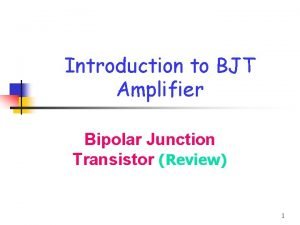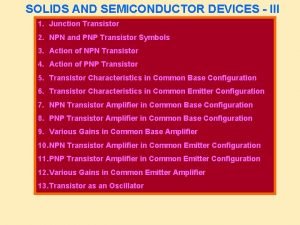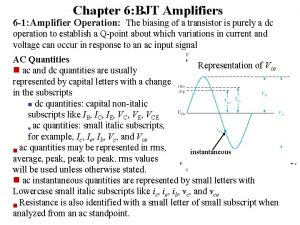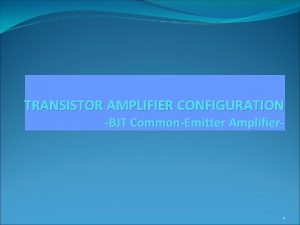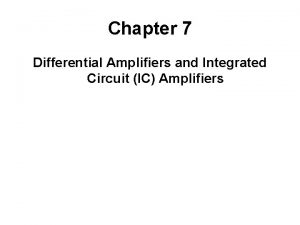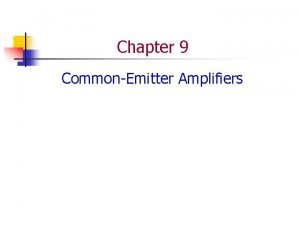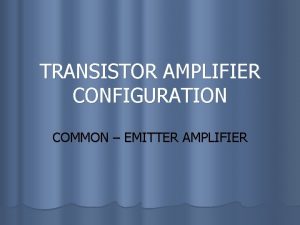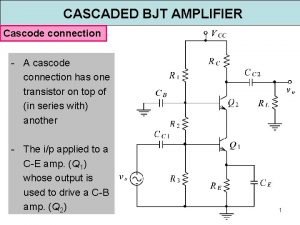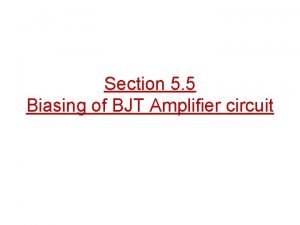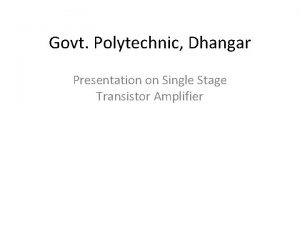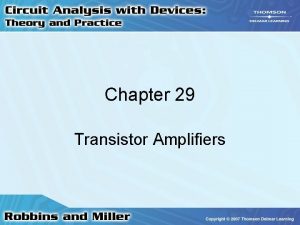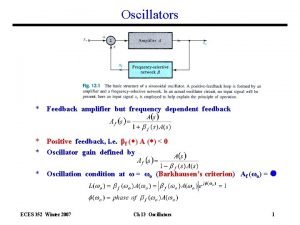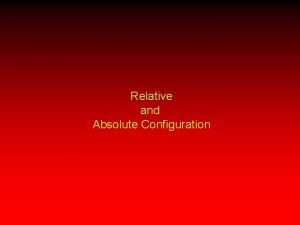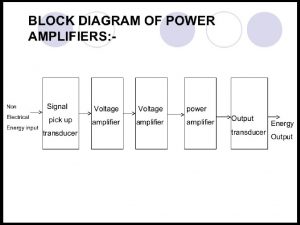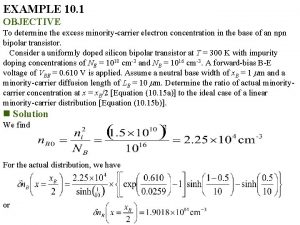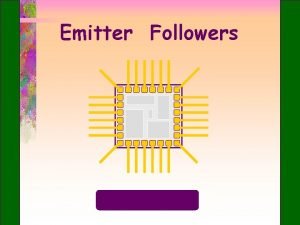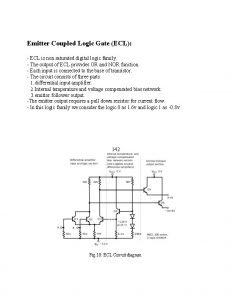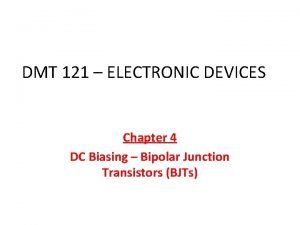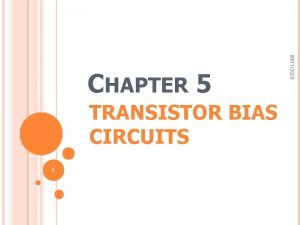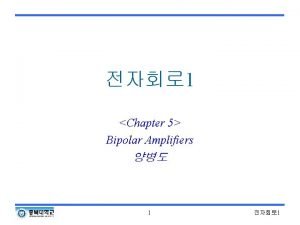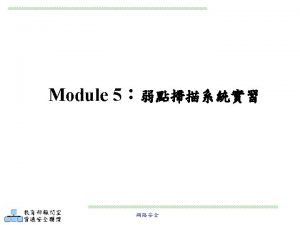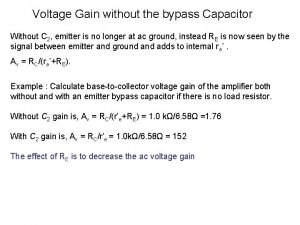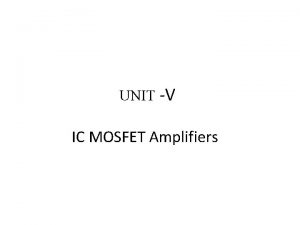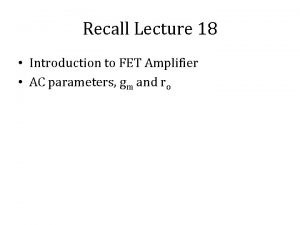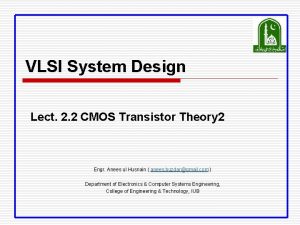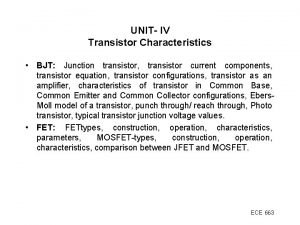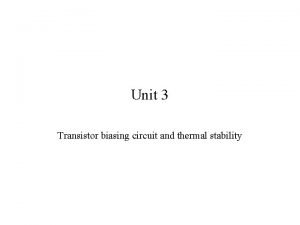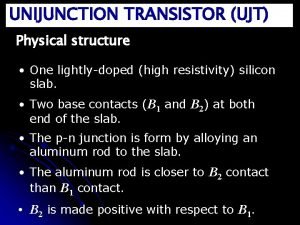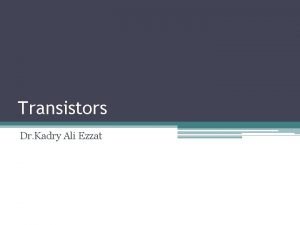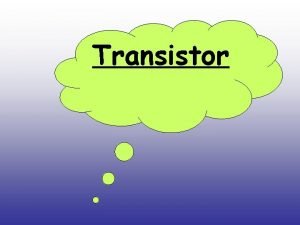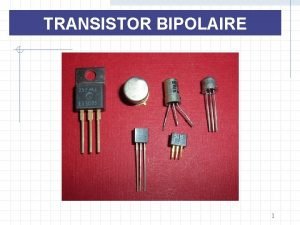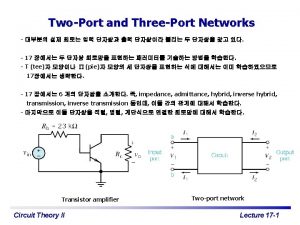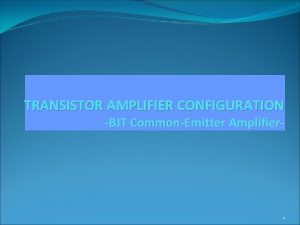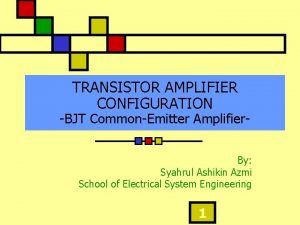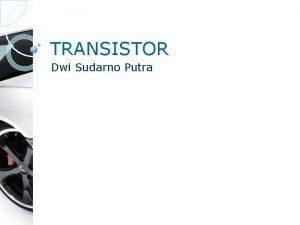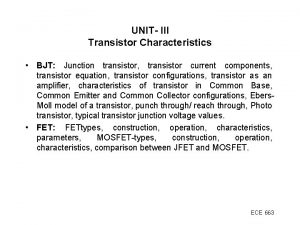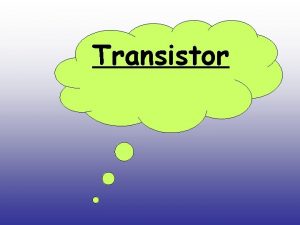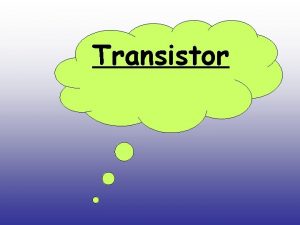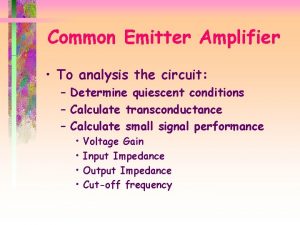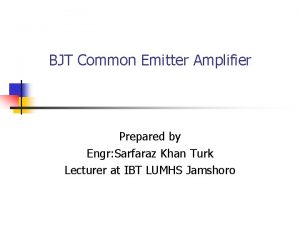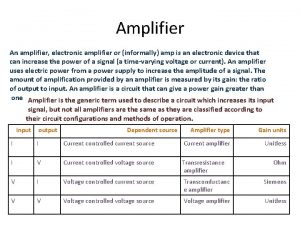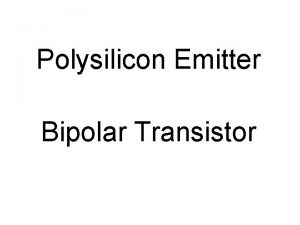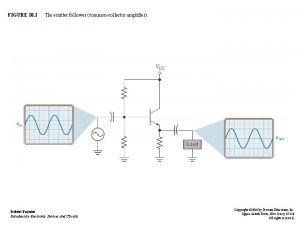TRANSISTOR AMPLIFIER CONFIGURATION COMMON EMITTER AMPLIFIER Introduction l




















































- Slides: 52

TRANSISTOR AMPLIFIER CONFIGURATION COMMON – EMITTER AMPLIFIER

Introduction l 3 basic single-transistor amplifier configuration that can be formed are: Common-emitter (C-E configuration) l Common collector / emitter follower (C-C configuration) l Common base (C-B configuration) l l Each configuration has its own advantages in form of: Input impedance l Output impedance l Current / voltage amplification l

Basic BJT Amplifier

Signal and load coupling

Basic amplifier dc analysis

Basic amplifier ac analysis

Common-emitter amplifier

Common-collector amplifier

Common-base amplifier

Basic common-emitter amplifier circuit -Figure a. Voltage divider biasing Coupling capacitor -> dc isolation between amplifier and signal source Emitter at ground -> common emitter

Cont. . Assume Cc =10μF and f=2 k. Hz. l Magnitude of capacitor impedance, |Zc| is: l l This impedance is much less than Thevenin resistance at capacitor terminal, that is: l So, assume capacitor is a short circuit to signals with f>2 k. Hz. Also neglect any capacitance effect within transistor. These assumptions will be used in later analysis.

Cont. . l From the previous circuit, small-signal equivalent circuit with Cc short-circuited is shown as below: Inside the transistor

Cont. .

Example 6. 5 l l l Determine small-signal voltage gain, input resistance and output resistance of the circuit in Figure a. β=100, VBE(on)=0. 7 V and VA = 100 V. 1 st step: DC solution Find Q-point values. ICQ = 0. 95 m. A VCEQ=6. 31 V.

Amplifier dc equations

Amplifier dc equations

Amplifier dc equations

Common-emitter dc equivalent circuit

Q-point

Q-point locus

DC load line change as Vcc change

DC load line change as Rc change

2 nd step: AC analysis (Example 6. 5) l Small-signal hybrid-π parameters are:

Cont ac analysis. . l Assume CC is short-cct, small-signal o/p voltage is: l Dependent current, gm. Vπ flow through parallel combination of ro and RC, but in direction that produces –ve o/p voltage. l Small-signal voltage gain is:

Cont. . l Input resistance, Ri is: l O/p resistance, Ro -> by setting independent source Vs = 0 -->no excitation to input portion, Vπ=0, so gm. Vπ=0 (open cct).

Cont Example 6. 5: Effect of RS l Using 2 -port equivalent cct with input signal source to determine the effect of RS with respect to input resistance, Ri. Using voltage divider equation, input voltage is actually: This is due to input resistance is almost equal to source resistance. The input voltage is reduced to 80% of source voltage. This is called loading effect. To minimize loading effect, try to make:

C-E with emitter resistor l l The basic common-emitter used in previous analysis cause a serious problem when: If BJT with VBE=0. 7 V is used, we get IB=9. 5μA and IC=0. 95 m. A but. . If a new BJT with VBE=0. 6 V is used, IB=26μA will make transistor goes into saturation not practical. Improved design include an emitter resistor.

Cont. . Q-point is stabilized against variation of β if emitter resistor included in cct. (in dc biasing design) l For ac signal, voltage gain with RE is less dependent on current gain, β. l Eventhough emitter is not ground potential, cct still referred as a commonemitter cct. l

Cont. . l Assume: Cc -> short circuit l Early voltage -> ∞, o/p resistance ro is neglected (open cct). l l

Cont. . l The ac output voltage is: (if we consider equivalent circuit with current gain β) l Input voltage equation: l Input resistance looking into the base of BJT, Rib: Resistance reflection rule l Input resistance to the amplifier is:

Cont. . l By voltage divider, we get relate Vin and Vs: l Small-signal voltage gain is then: l If Ri>>RS and if (1+β)RE >> rπ, voltage gain is:

Example 6. 6 l Determine the small-signal voltage gain and input resistance of C-E circuit with an emitter resistor. β=100, VBE(on)=0. 7 V and VA=∞.

Cont example 6. 6 l Small-signal equivalent circuit of C-E with RE

C-E Amplifier with Emitter Bypass Capacitor CE provides a short circuit to ground for the ac signals

Cont. . By include RE, it provide stability of Q-point. l If RE is too high +++> small-signal voltage gain will be reduced severely. (see Av equation) l l l Thus, RE is split to RE 1 & RE 2 and the second resistor is bypassed with “emitter bypass capacitor”. CE provides a short circuit to ground for ac signal. So, only RE 1 is a part of ac equivalent circuit. For dc stability: RE=RE 1+RE 2 For ac gain stability: RE=RE 1 since CE will short RE 2 to ground.

AC Load Line Analysis l l Dc load line -> a way of visualizing r/ship between Q-point and transistor characteristic. When capacitor included in cct, a new effective load line ac load line exist. Ac load line -> visualizing r/ship between smallsignal response and transistor characteristic. Ac operating region is on ac load line.

Ac load line

Ac load line For Dc load line: l Apply KVL around collector-emitter loop, l l But l Substitute and rearrange both equations: l If β>>1, then we can approximate Dc load line equation

Cont. . l For ac analysis, apply KVL around collector-emitter loop, l Assume ic ≈ ie, l The slope is given by: l The slope of ac load differ from dc load line RE 2 is not included in the equivalent circuit. Small-signal C-E voltage and collector current response are functions of resistor RC and RE 1.

Dc and ac load lines for CE circuit

AC operation

AC load line + IC Q ICQ 0 VCEQ + VCE

WAVEFORMS

Maximum symmetrical swing When symmetrical sinusoidal signal applied to i/p of amplifier, symmetrical sinusoidal signal generated at o/p. l Use ac load line to determine the maximum output symmetrical swing. l If output exceed limit, a portion of o/p signal will be clipped and signal distortion occur. l

1. draw the ac load line 2. add the Q point 3. add ib~ vin IC Q ac load line 0 4. add reference lines 5. sketch ic 6. sketch vce VCE

SATURATION & CUT- OFF REGIONS RESTRICT MAXIMUM UNDISTORTED SIGNAL

Maximum undistorted signal

BIAS (ICQ) BELOW LOAD LINE CENTRE ac load line IC ICmax Q ICQ 0 VCEQ VCE

BIAS (ICQ) ABOVE LOAD LINE CENTRE ac load line ICmax IC Q ICQ 0 VCEQ

SATURATION DISTORTION ac load line IC ICQ 0 Q VCE

CUT-OFF DISTORTION ac load line IC ICQ 0 Q VCE

CLIPPING ac load line IC ICQ 0 Q VCE
 Bjt as an amplifier
Bjt as an amplifier Pnp common emitter amplifier
Pnp common emitter amplifier Multistage amplifier
Multistage amplifier In a c-e configuration an emitter resistor is used for
In a c-e configuration an emitter resistor is used for Emitter coupled differential amplifier
Emitter coupled differential amplifier The emitter of a swamped amplifier
The emitter of a swamped amplifier Contoh soal rangkaian transistor
Contoh soal rangkaian transistor Ac load line analysis of transistor
Ac load line analysis of transistor Cascade connection of transistors
Cascade connection of transistors Bjt amplifier circuit
Bjt amplifier circuit Single stage transistor amplifier
Single stage transistor amplifier Purpose of capacitor in transistor amplifier
Purpose of capacitor in transistor amplifier Tanggapan frekuensi rendah penguat transistor
Tanggapan frekuensi rendah penguat transistor Transistor as an amplifier derivation clause
Transistor as an amplifier derivation clause Relative configuration
Relative configuration Chiral and achiral meaning
Chiral and achiral meaning Electron configuration vs noble gas configuration
Electron configuration vs noble gas configuration Absolute and relative configuration
Absolute and relative configuration Difference between power and voltage amplifier
Difference between power and voltage amplifier Metallurgical base width
Metallurgical base width Emitter follower
Emitter follower Ecl gate
Ecl gate Dc bias with voltage feedback
Dc bias with voltage feedback Basic electronics
Basic electronics Need for stabilization
Need for stabilization Vcc=icrc+vce
Vcc=icrc+vce Q point bjt
Q point bjt Voltage regulators keep a constant
Voltage regulators keep a constant Arduino ultrasonic transducer
Arduino ultrasonic transducer Digital advertising nez
Digital advertising nez Imagem
Imagem Bednarik-kaimanoff emitter
Bednarik-kaimanoff emitter Common configuration enumeration
Common configuration enumeration Common collector configuration circuit diagram
Common collector configuration circuit diagram A cs amplifier utilizes a mosfet with
A cs amplifier utilizes a mosfet with Gmvgs
Gmvgs Relation between ib and ie
Relation between ib and ie Common factors of 12 and 24
Common factors of 12 and 24 Common anode and common cathode
Common anode and common cathode Common factors and common multiples
Common factors and common multiples What are the factors for 54
What are the factors for 54 Factors of 18
Factors of 18 Multiples of 9 and 21
Multiples of 9 and 21 Common lisp a gentle introduction to symbolic computation
Common lisp a gentle introduction to symbolic computation Vlsi transistor
Vlsi transistor Unit of transistor
Unit of transistor Thermal stability in bjt
Thermal stability in bjt Structure of ujt
Structure of ujt Uses of bjt
Uses of bjt Transistor dikatakan cut off jika
Transistor dikatakan cut off jika Npn
Npn Transistor bipolaire
Transistor bipolaire Schema equivalent transistor
Schema equivalent transistor
